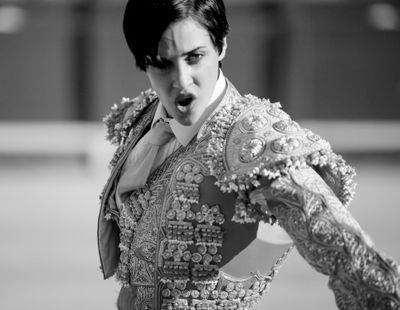Silent film meets fable, to captivating effect

At first glance, “Blancanieves” looks like a gimmick: It’s a Spanish film based loosely on the story of Snow White, and it’s photographed to resemble a black-and-white silent film from the earliest days of narrative cinema. But, like 2011’s mostly silent Best Picture winner “The Artist,” this is the case of convention breeding invention, and director Pablo Berger is artistically liberated by his techniques when most filmmakers would be shackled by them.
Spain’s official selection as Best Foreign Film for this year’s Oscars (it wasn’t nominated), “Blancanieves” begins in the tradition of grand, lurid melodramas. In 1920s Seville, a famed bullfighter is gored in the ring, and his pregnant wife goes into labor as she looks on. She dies giving birth, and her husband, now paralyzed, rejects his newborn daughter in grief.
The child, named Carmen, is treated viciously (as all fairy tale princesses must be) by her father’s former nurse and new wife (Maribel Verdú, “Y Tu Mamá También”), who forces the girl into menial chores and forbids her from seeing her wheelchair-bound father. Of course, Carmen grows up to be a beautiful young woman, played by the enchanting Macarena García, and of course she has aspirations beyond the walls of her stepmother’s chilly mansion.
The rest of “Blancanieves” follows the basic beats of the Snow White fable – there’s a botched murder attempt in a forest, a poisoned apple and, yes, a clan of seven dwarves. But the movie isn’t all happily ever after, as the tone here is more in line with the brothers Grimm than Walt Disney, and the odds of a dashing prince rushing in to save the day are very low.
Like Michel Hazanavicius, who wrote and directed “The Artist,” Berger clearly has a deep respect for the form, and his lively editing and imaginative camerawork evoke the most playful silent films of F.W. Murnau and Luis Buñuel. “Blancanieves” isn’t just a dry directorial exercise, though; it’s dynamic, lush and engaging, and filled to the brim with creative filmmaking tricks.
Let’s not kid ourselves: Silent movies will never come back into vogue. The popularity of “The Artist” (as good as it is) was a fluke, a product of buzz and marketing as opposed to a newfound clamoring for nontalkies. Hopefully, though, movies like “The Artist” and “Blancanieves” will inspire modern audiences to look back through film history and gain an appreciation for an antiquated art.
I’m sure anyone well-versed in silent movies will marvel at Berger’s use of montage, dramatic lighting, visual layering and expressive music (the flamenco-tinged score, which almost becomes a character in itself, is by Alfonso de Vilallonga). But “Blancanieves” has an infectious spirit that those outside of film geek circles will recognize, and it’s the rare stylistic experiment that works both as homage and as entertainment.